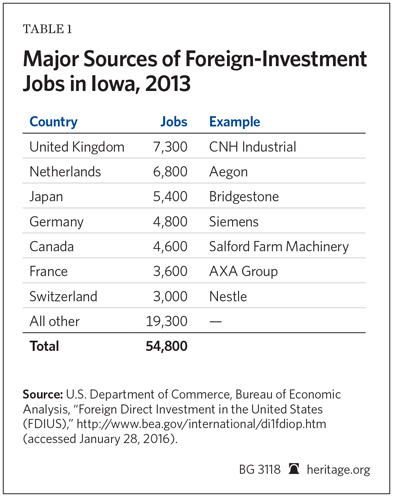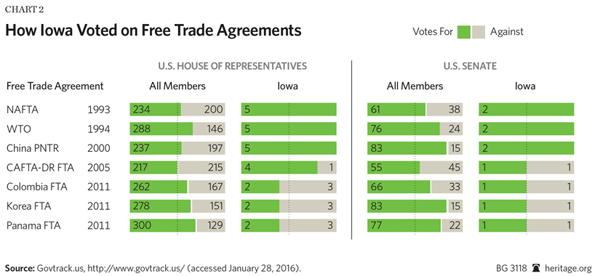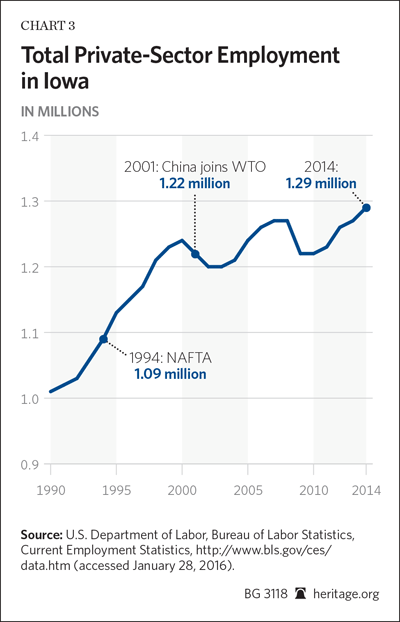Hundreds of thousands of Iowans rely on international trade and investment for their jobs. The benefits of international commerce used to be reflected in the voting record of the state’s congressional delegation, which overwhelmingly supported the North American Free Trade Agreement (NAFTA) and the Uruguay Round trade agreement. However, support was split for more recent trade agreements with Colombia, Panama, and South Korea in 2011.
U.S. trade barriers protect politically well-connected companies from competition while driving up prices for consumers. Iowa’s congressional delegation can best represent the state’s interests by opposing protectionist policies.
Imports Create Jobs and Benefit Consumers
Over 340,000 Iowans are employed in the wholesale, retail, and truck or rail transportation industries, moving and selling goods made in the U.S. and around the world.[1]
Many Iowans rely on imports for the fresh fruit and vegetables at their local supermarkets during the winter months, as well as for the flowers they send on Valentine’s Day. According to the U.S. Department of Agriculture (USDA):
U.S. consumers have benefited from an increased volume and variety of fresh fruit imports, particularly since the 1990s. The produce section in today’s grocery store often has dozens, if not hundreds, of different fresh fruits on display all year around, which come from all corners of the globe (e.g., grapes from Chile, kiwi fruit from New Zealand, and mangoes from Mexico) as additions to domestic fresh fruit. Improved logistics, technology, and transportation have supported this increase in imports.
While imports contribute to year-round fresh fruit availability, they likely also account for some of the increase in consumer demand. In the aggregate, fresh fruit imports lower domestic prices and smooth out price fluctuations—potential stimuli for increased consumer demand. Meanwhile, fresh fruit imports—which bring a wider selection of fresh fruit to U.S. consumers year round—have added to U.S. consumers’ ability to fulfill the goals of increasing fruit (and vegetable) consumption as recommended by current dietary guidelines, especially given preferences for fresh produce.[2]
In 2012, 90 percent of the flowers Americans sent for Valentine’s Day originated from countries like Colombia and Ecuador.[3]
Consumers are not the only ones who benefit from imports. Over half of U.S. imports are intermediate goods used by U.S. manufacturers. According to a study by the Peterson Institute for International Economics, the use of imported inputs from 1961–2000 added $1.1 trillion to the U.S. economy, equivalent to $9,400 per household.[4]
Exports Boost Iowa’s Economy, Too
According to the U.S. International Trade Administration, 107,000 Iowa jobs are supported by exports.[5] Exports of goods from Iowa are up 13.3 percent since 2011, from $13.3 billion to $15.1 billion.[6]
Many sectors of Iowa’s economy benefit from exports. Exports account for nearly one-fourth of Iowa’s manufacturing jobs.[7] In 2014, Iowa exported $11.3 billion in agricultural commodities. These exports account for more than one-third of Iowa farm receipts.[8]
According to USDA deputy undersecretary Alexis Taylor, “Iowa is second in the nation in total food and ag exports, and it’s fourth in beef exports.”[9] Iowa is the country’s largest exporter of commodities including soybeans, pork, corn, feeds and fodder, and processed grain products.[10]
Iowa’s service industries provide another source of export income. Service industries accounted for $3.2 billion in Iowa exports in 2013, including $576 million in insurance services and over $957 billion in travel and transportation exports.[11]
U.S. free trade agreements have expanded Iowa’s export opportunities. More than half of the state’s exports go to countries that have trade agreements with the U.S.[12]
Foreign Investment Supports Iowa Jobs
One often-heard concern is that U.S. workers cannot compete with low-wage workers in other countries, but the facts indicate otherwise. The U.S. is a magnet for job-creating foreign investment. In Iowa, over 54,000 people work for U.S. affiliates of foreign companies ranging from Aegon Insurance, which has its U.S. headquarters in Cedar Rapids, to Zurich’s UBS Financial Services.[13] If considered as a single entity, these foreign-owned firms would be the largest private employer in the state, accounting for 3.3 percent of all private-sector jobs. Half of these are manufacturing jobs, like the 600 jobs for building dozers and farm equipment for Fiat-owned Case IH in Burlington.[14]
According to Iowa’s economic development agency:
The state of Iowa is the perfect place to expand, locate or start a business. The state’s pro-business policies, nationally recognized research centers and legendary Midwestern work ethic give businesses with an Iowa location a huge competitive edge. Those business advantages paired with a low cost of doing business, central location, abundant raw materials and efficient transportation infrastructure continue to fuel Iowa’s economy. High growth industries in Iowa include advanced manufacturing, financial services, biosciences, renewable energy, food manufacturing and information technology.[15]
Iowa’s Elected Officials and Free Trade
In the late twentieth century, Iowa legislators consistently supported free trade, promoting the ability of people in Iowa to reap the benefits of global commerce.
Every Iowa Senator and Representative supported NAFTA, the Uruguay Round trade agreement, the creation of the World Trade Organization (WTO), and China’s entry into the WTO.[16]
In recent years, support for trade among Iowa’s legislators has not been as strong. There was a party line split in support for trade agreements with Colombia, Korea, and Panama, with Republican legislators supporting free trade agreements and Democrats opposing them.
International Trade Is Not Responsible for Job Losses
According to the Economic Policy Institute (EPI), trade with China cost Iowa 20,300 net jobs from 2001 to 2011.[17] The EPI further claims that NAFTA cost Iowa 6,500 net jobs as of 2010.[18]
Both of these claims are misleading. Economic opportunities created by trade and technology create new jobs in some industries while reducing employment in others, but there has been no net loss of jobs in Iowa due to trade with businesses in Mexico, China, or elsewhere. From 2001 to 2014, total Iowa private-sector employment increased by more than 5 percent. Moreover, since NAFTA took effect in 1994, Iowa has added more than 200,000 net new private-sector jobs.[19] There is no reason to believe Iowa would have even more jobs if the United States banned trade with China and Mexico.
Public Citizen claims that Iowa has lost 8,843 manufacturing jobs since NAFTA took effect in 1994.[20] However, that is not to say that NAFTA is responsible for those job losses. In fact, Iowa’s manufacturing output is significantly higher now than it was in 1994, even after adjusting for inflation. Iowa’s real manufacturing gross domestic product (GDP) has increased by over 26 percent since 2000.[21]
The Sugar Program Hurts Iowa
The federal government artificially inflates sugar prices by imposing tariff-rate quotas that effectively cap the amount of sugar that food manufacturers and consumers in the U.S. can buy from producers in other countries. In 2015, bakeries and candy companies paid twice as much as their foreign competitors for refined sugar. From 2000 to 2015, Americans paid an average of 85 percent more for refined sugar than people in other countries.[22]
This is a bad trend for consumers and companies alike. For example, Ferrara Candy Company, which employs 330 people in Creston, Iowa, and produces 80 million pounds of Jujyfruits and other gummy candies a year, continues to be penalized by the sugar program.[23] Many workers in the confectionary industry have lost their jobs as factories closed due to high sugar prices. In 2005, Ferrara’s then-president observed: “Until we get relief on sugar we have to keep looking to open plants overseas.”[24] High U.S. barriers on products like sugar encourage other countries to maintain similar barriers on exports of competitive U.S. products such as pork and grain.
Senator Charles Grassley (R–IA) and Representative Steve King (R–IA) voted to reform the sugar program in 2013, but every other member of the state’s congressional delegation opposed reform.[25]
Restrictions on Cargo and Cruise Vessels Weaken Iowa’s Economy
The Merchant Marine Act of 1920, commonly known as the Jones Act, and the Passenger Vessel Services Act (PVSA) of 1886 require that ships transporting goods or people between two points in the U.S. must be built in the U.S., mostly U.S.-owned, and mostly crewed by U.S. citizens. These laws are designed to protect U.S. shipbuilders from competition, but they impose steep costs on Americans who use ships for domestic transportation.
According to the U.S. Department of Homeland Security: “The coastwise laws are highly protectionist provisions that are intended to create a ‘coastwise monopoly’ in order to protect and develop the American merchant marine, shipbuilding, etc.”[26]
Cato Institute Senior Fellow Dan Pearson has observed: “The United States as a whole produces plenty of livestock feedstuffs—particularly corn and soybeans—more than any other country. From a North Carolina perspective, too much of those crops grow in the wrong place. Des Moines, IA, for example, is in the heart of the Midwest. It also is well over 1000 miles away from livestock producers in North Carolina.”[27] The Jones Act harms Iowa farmers by increasing the price of shipping grain domestically, since foreign-built vessels cannot transport grain along the Mississippi River or from the Gulf Coast to pork producers in North Carolina and elsewhere in the U.S.
Additionally, U.S. cargo preference mandates, which require a majority of food aid and other government-funded cargo to be shipped on U.S.-flagged vessels, harm Iowa’s farmers. According to the Congressional Research Service, “It appears preference cargo now accounts for almost all of the revenues of the U.S.-flag international fleet. U.S.-flag ships do not appear competitive with foreign-flag ships in carrying the overwhelming bulk of exports and imports transacted in the private sector.”[28] According to a study by the American Enterprise Institute, “Cargo Preference for Food Aid (CPFA), which requires at least 50 percent of all food aid to be sourced and shipped on U.S.-flagged vessels, resulted in an additional $140 million to $200 million in wasted spending on shipping costs from January 2012 to May 2015.”[29]
The Iowa Soybean Association has consistently supported a waiver of Jones Act shipping requirements. It also supports reform of U.S. cargo preference mandates.[30] Iowa’s farmers should be allowed to ship cargo on foreign-built ships.
Iowa’s Future is Bright
Iowa is positioned to prosper from continued growth in trade with the rest of the world as trade barriers are reduced. Physical barriers, such as the limits imposed by canals and ports unable to handle modern cargo ships, and governmental barriers, like limits on shipping and the use of imported inputs, are falling across the globe. Iowa’s congressional delegation should take the lead in making sure U.S. government impediments to trade and prosperity fall as well.
—Bryan Riley is Jay Van Andel Senior Analyst in Trade Policy in the Center for Trade and Economics, of the Institute for Economic Freedom and Opportunity, at The Heritage Foundation.






